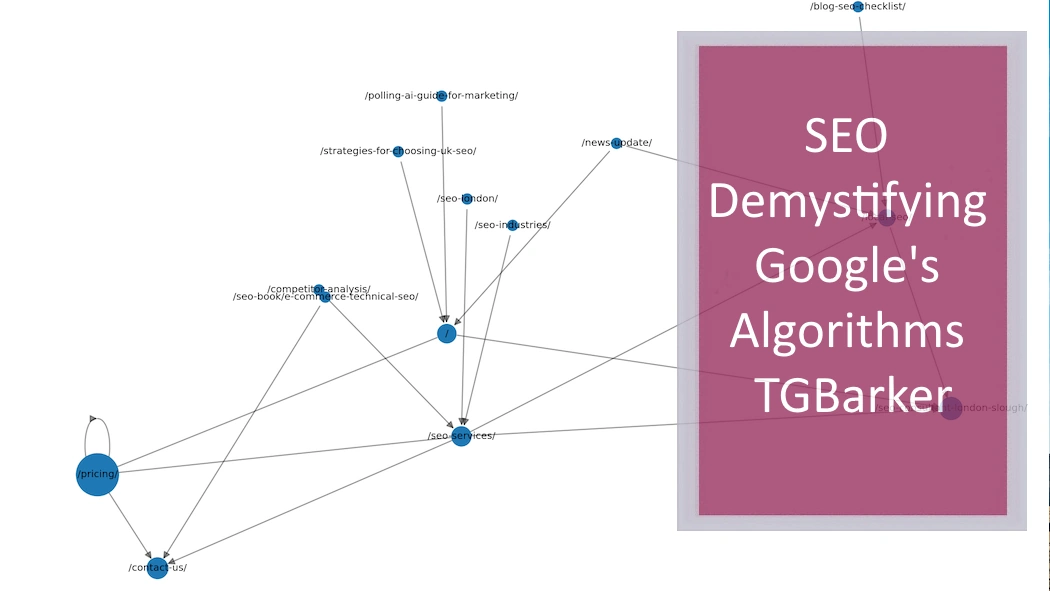
The Hidden Mathematics Behind Search
When Google’s founders created the original PageRank algorithm, they weren’t thinking in marketing terms — they were thinking in mathematics. They wanted a way to rank pages based on their importance within the entire web.
To do that, they used graph theory. Imagine the web as a huge map of dots and arrows: each dot is a web page, and each arrow is a link from one page to another. Pages with more incoming arrows (links) from other important pages gain more authority. This basic structure is still the foundation of how Google understands the web — a massive, dynamic graph of connections.
Now, add Markov chains to the mix — models that describe how something moves from one state to another based on probability. In SEO terms, that means estimating how a user (or crawler) might move from one page to the next.
If 80% of visitors who land on your homepage go to your SEO services page next, that’s a high-probability transition. If very few ever find your contact page, Google may interpret that as low navigational importance — even if the content is good. In short: links create probabilities, and those probabilities form patterns that algorithms use to rank importance and usability.
What Is Graph Theory in SEO Terms?
Graph theory looks at relationships between connected points (nodes). In your website, those nodes are pages, and the links between them are edges.
- Your homepage might link to your About, Services and Contact pages.
- Each service page might link to a relevant blog post or case study.
- Those blog posts link back to your service pages or homepage.
This creates a web-like structure that search engines can crawl efficiently. The more connected, logical, and hierarchical this structure is, the easier it is for Google to understand your site’s topic and relevance.
A well-connected internal link structure helps to:
- Pass link equity (authority) from strong pages to weaker ones.
- Reinforce topic clusters (pages about the same theme).
- Improve crawlability — ensuring Google can find and index all your pages.
- Reduce “orphan” pages that get no visibility at all.
Without a clear internal graph, your website becomes like a broken road map — even if the content is brilliant, search engines struggle to see how it all fits together.
What Is a Markov Chain, and Why Does It Matter?
A Markov chain models the probability of moving from one state to another — in our case, from one web page to the next. The original PageRank algorithm used this idea to simulate a “random surfer”: someone who clicks on a link, then another, and another.
- There’s a 40% chance they’ll go from the homepage to your About us.
- A 20% chance they’ll go to a blog article.
- A 10% chance they’ll go to “Contact”.
Multiply this across every page on your site, and you get a transition matrix — a table showing the likelihood of moving between all pages. Over time, this system “stabilizes” and reveals which pages are most likely to be visited — effectively your strongest pages in Google’s eyes.
That’s why your internal linking strategy has a measurable mathematical effect on SEO. Each link you add isn’t just a shortcut — it’s a probability shift that tells Google what’s important.
Why This Matters for Businesses (Especially Older Ones)
Many long-standing businesses still think of SEO as a checklist: title tags, meta descriptions, and keywords. But today, search engines operate more like ecosystems. They simulate how people use your site.
If your pages are isolated, poorly linked, or rely on outdated navigation structures, Google can interpret your site as confusing or incomplete. This explains why modern competitors sometimes outrank established brands.
By improving your internal linking you can:
- Increase the likelihood that both users and Google bots reach key pages such as your SEO Services page.
- Distribute PageRank more effectively throughout your site.
- Encourage deeper exploration and higher engagement.
The result is not just better rankings, but better engagement metrics: lower bounce rates, more page views per visit, and longer dwell time — all of which reinforce your perceived authority.
How to Apply This Knowledge Practically
- Map your site — use a crawler (e.g., Screaming Frog or Sitebulb) to see your current internal link graph.
- Identify orphan or low-linked pages — add meaningful links from higher-traffic or higher-authority pages.
- Cluster by topic — link together pages that serve a shared search intent (for example, all “SEO” articles linking to your SEO services page).
- Simplify navigation — too many links dilute probabilities; favor clarity and hierarchy.
- Monitor behaviour — watch which pages users visit next; tweak links to guide them naturally.
Final Thought
SEO has evolved from a list of tactics into a discipline of understanding systems. Markov chains and graph theory might sound abstract, but they describe something practical: the pathways people take through your site and how Google perceives them. Once you start seeing your website as a living network — not a collection of isolated pages — SEO becomes less about chasing keywords and more about building meaningful connections.
SEO Consultant Services Offered:
The services offered combine technical expertise and strategic insight to help your website achieve stronger search results and long-term stability.

